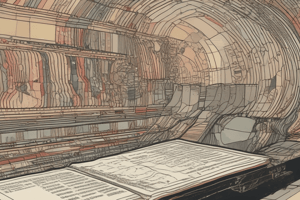Podcast
Questions and Answers
An archive serves as a repository for a variety of materials. Which of the following best describes the core purpose for preserving these materials?
An archive serves as a repository for a variety of materials. Which of the following best describes the core purpose for preserving these materials?
- To maintain records that provide evidence of an organization's functions and responsibilities or contain information of enduring value. (correct)
- To showcase aesthetically pleasing documents and artifacts.
- To store any and all documents produced by an organization, regardless of their content or relevance.
- To create a comprehensive collection of materials for entertainment purposes.
When distinguishing between 'archives' and 'manuscripts,' which statement accurately describes a key difference?
When distinguishing between 'archives' and 'manuscripts,' which statement accurately describes a key difference?
- Manuscripts always have greater historical significance than archives.
- Archives are permanently valuable records of organizations, businesses, and governments, whereas manuscripts are historical or literary records of individuals and families. (correct)
- Archives consist of personal papers, while manuscripts hold records of organizations and governments.
- There is no practical difference; the terms are interchangeable.
A historian is researching the social impact of a specific company in a town. They consult both the company's internal records and the personal letters of the town's residents during that period. Which of the following best describes these sources?
A historian is researching the social impact of a specific company in a town. They consult both the company's internal records and the personal letters of the town's residents during that period. Which of the following best describes these sources?
- Both the company records and personal letters are secondary sources.
- The company's internal records are primary sources, while the personal letters are secondary sources.
- Both the company records and personal letters are primary sources. (correct)
- The company's internal records are secondary sources, while the personal letters are primary sources.
A researcher uses a book review to understand a novelist's intentions in writing their book. What type of source is the book review in this scenario?
A researcher uses a book review to understand a novelist's intentions in writing their book. What type of source is the book review in this scenario?
An archival institution primarily collects records from its parent organization, like a university preserving its administrative and academic documents. What type of archive is this?
An archival institution primarily collects records from its parent organization, like a university preserving its administrative and academic documents. What type of archive is this?
If an archive aims to document the history of a local community by gathering documents both from local government offices and personal collections of residents, what type of archive would this be classified as?
If an archive aims to document the history of a local community by gathering documents both from local government offices and personal collections of residents, what type of archive would this be classified as?
Within an archive, what does the appraisal process primarily involve?
Within an archive, what does the appraisal process primarily involve?
Which of the archival functions involves creating finding aids and indexes to help researchers locate relevant materials within a collection?
Which of the archival functions involves creating finding aids and indexes to help researchers locate relevant materials within a collection?
Apart from scholars and historians, which group commonly utilizes archives to trace family lineages and histories?
Apart from scholars and historians, which group commonly utilizes archives to trace family lineages and histories?
What is the main difference between primary and secondary resources?
What is the main difference between primary and secondary resources?
Flashcards
Archives
Archives
Materials created/received by an entity (person, family, organization) during their activities, preserved for their enduring informational or evidentiary value.
Archives (Records)
Archives (Records)
Records of organizations, businesses, and governments that have permanent value.
Manuscripts (Papers)
Manuscripts (Papers)
Historical or literary records of individuals and families.
Primary Sources
Primary Sources
Signup and view all the flashcards
Secondary Sources
Secondary Sources
Signup and view all the flashcards
Institutional Archives
Institutional Archives
Signup and view all the flashcards
Collecting Archives
Collecting Archives
Signup and view all the flashcards
Combination Archives
Combination Archives
Signup and view all the flashcards
Main Archival Functions
Main Archival Functions
Signup and view all the flashcards
Who Uses Archives?
Who Uses Archives?
Signup and view all the flashcards
Study Notes
- Study notes about field methods in psychology relating to archives
Definition of Archives
- Archives consist of materials created or received by an entity, be it a person, family, or organization, which are preserved due to their enduring value in terms of information or evidence of the creator's functions
- Archives can refer to a division within an organization maintaining records, or the organization itself which collects archives
- It can also refer to the professional discipline of administering collections or the building that houses archival collections
- It also refers to a published collection of scholarly papers
Archives and Manuscripts
- Archives are permanently valuable records of organizations, businesses, and governments
- Manuscripts are historical or literary records of people and families
Primary vs. Secondary Sources
- Primary sources originate during the event being studied or are created afterward by a participant, reflecting their perspective
- Primary sources allow researchers direct access to historical events or periods
- Secondary sources are works that rely on other sources of information rather than direct observation
- These works comment on primary sources through reviews, criticism, and commentaries
Types of Archives
- Institutional archives acquire and maintain records of a parent organization or related entities
- Collecting archives gather materials related to a specific area
- Combination archives collect both institutional records and external materials that document a local area or subject
Main Archival Functions
- Archival functions include acquisition, appraisal, arrangement and description, preservation and storage, reference and access, and outreach activities
Common Archive Users
- Archives are used by staff members, scholars, professors, students, historians, genealogists, and hobbyists
Studying That Suits You
Use AI to generate personalized quizzes and flashcards to suit your learning preferences.




